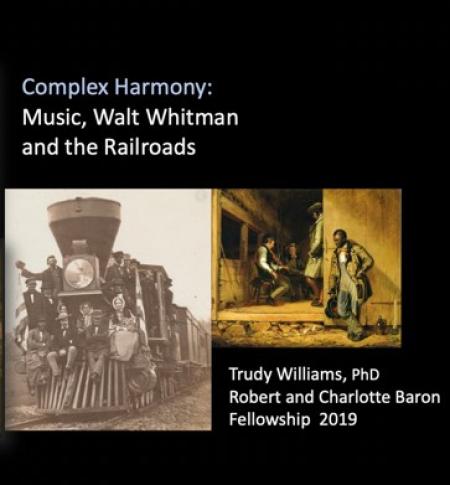My research residency confirmed again how the direct, unfiltered experience of examining an artifact creates a moment of connection, empathy, wonderment and expansion similar to the moments of shared experience in a live performance. A chance for a fuller narrative opens up, independent of interpretive trends, making way for me as a dramatist to offer general audiences new emotional, creative identifications and understandings, experienced through the electricity of shared discovery.
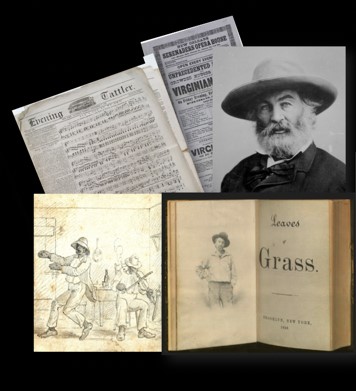 During my month long residency at AAS as a Fellow, I began primary research for "Complex Harmony: Music, Walt Whitman, and the Railroads", a theatrical program I am writing that combines a research-based narration, musical performance, theatrical roles, and large scale artifact images to give general audiences factual and interpretive connections between the soundscape of Walt Whitman’s 19th century America, the music he was passionate about, the influence of his musical interests on his poetic voice, and the social and cultural impact of the railroads, which he loved. Conveyed in this experiential tour will be elements of the simultaneous contractions and expansions that characterized aspects of the poet’s evolution and the entwined, often conflicting 19th century American cultural and social rail-provoked and rail-enabled transformations.
During my month long residency at AAS as a Fellow, I began primary research for "Complex Harmony: Music, Walt Whitman, and the Railroads", a theatrical program I am writing that combines a research-based narration, musical performance, theatrical roles, and large scale artifact images to give general audiences factual and interpretive connections between the soundscape of Walt Whitman’s 19th century America, the music he was passionate about, the influence of his musical interests on his poetic voice, and the social and cultural impact of the railroads, which he loved. Conveyed in this experiential tour will be elements of the simultaneous contractions and expansions that characterized aspects of the poet’s evolution and the entwined, often conflicting 19th century American cultural and social rail-provoked and rail-enabled transformations.
As we do now, Whitman’s America faced unsustainable structures and conditions with unimaginable solutions, yet moved forward, creating a legacy of gifts and burdens. Intended as entertaining and informative (with a sing-along component and Q&A at the end), the program will end with an invitation to consider that the gifts seeded in the 19th century come from a still present continuity of individual and collective strengths that we can choose to draw on as we face our times’ critically urgent needs. Embedded in the program’s conclusion are thoughts on the role of artifacts and our continued support for their care and access as an essential component for our humanity, contributing to what informs the decisions we make today that become our future tomorrow.
Soundscape: Musical activities in the aural tradition and sheet music beyond the parlor
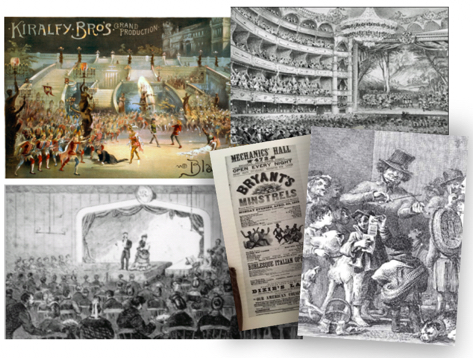 The many forms of the 19th century soundscape reflect the inter-racial and multi-ethnic borrowings and cultural border-crossing exchanges between and among the vernacular arts culture, as well as the economic and educational forces that sought to establish formal musical literacy and related goods and publications for popular consumption. Boundaries of “high” and “low” culture, what and who ‘mattered’ or not, solidified. Improvements in publishing and distribution, and the ability to build larger permanent performance venues, aided the growing commodification of culture. With equal force, vernacular cultural engagements with its participatory enjoyment and creativity, continued, especially in the singing and dancing that was so much a part of everyday life.
The many forms of the 19th century soundscape reflect the inter-racial and multi-ethnic borrowings and cultural border-crossing exchanges between and among the vernacular arts culture, as well as the economic and educational forces that sought to establish formal musical literacy and related goods and publications for popular consumption. Boundaries of “high” and “low” culture, what and who ‘mattered’ or not, solidified. Improvements in publishing and distribution, and the ability to build larger permanent performance venues, aided the growing commodification of culture. With equal force, vernacular cultural engagements with its participatory enjoyment and creativity, continued, especially in the singing and dancing that was so much a part of everyday life.
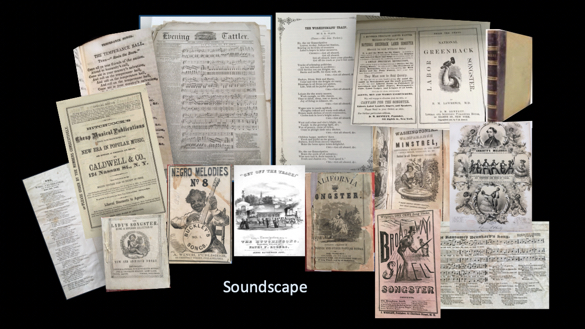
Railroad Music, Songsters and Broadsides
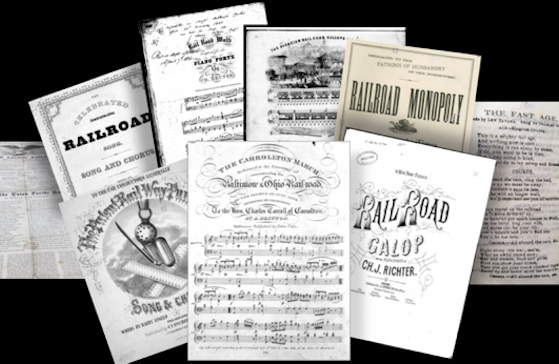 Music is distinctive in every period of our history. Whether created and experienced in the aural tradition or publication, it is a reliable portal into the personal, social and civic experiences, interests, hopes, fears, failures and pride of the prevailing historical and cultural ecosystem. Sheet music, songsters and broadsides are some of many cultural forms that attest to the massive impact of the railroads on American life.
Music is distinctive in every period of our history. Whether created and experienced in the aural tradition or publication, it is a reliable portal into the personal, social and civic experiences, interests, hopes, fears, failures and pride of the prevailing historical and cultural ecosystem. Sheet music, songsters and broadsides are some of many cultural forms that attest to the massive impact of the railroads on American life.
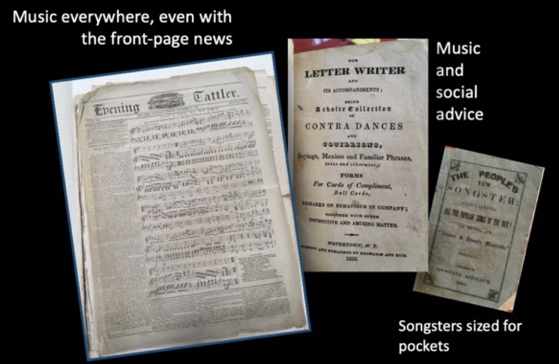 Some of my favorite artifact encounters were with what people used, held in their hands and carried in their purses and pockets.
Some of my favorite artifact encounters were with what people used, held in their hands and carried in their purses and pockets.
Whitman’s 1845 Statement on American Music
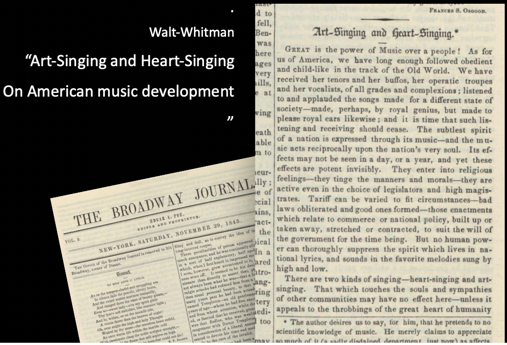
Railroad Guides
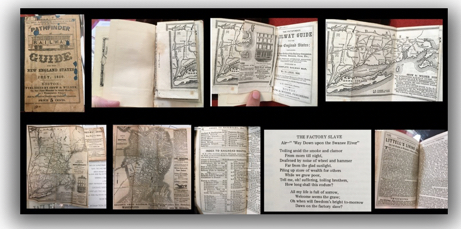
The pocket-sized Railway Guides were published weekly. The new technology of railroads changed the timing, pace, and in many cases, place, of people’s lives, while publishers created an association between depot timetables, social advice, editorials on hot issues, poetry, lyrics, pull out maps, advertisements and other information promoted as essential to have at hand, in your pocket or purse. Much like our smart phones today.
Account Books
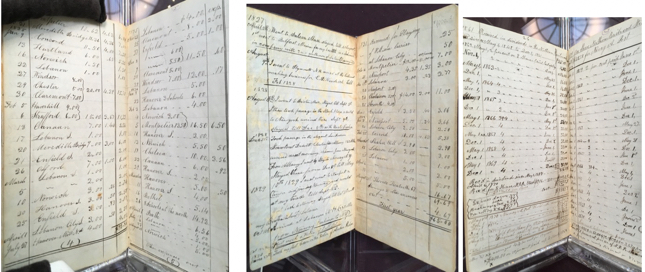 The Fiddler’s Account Book was a consistent record of work activity (teaching and performing) and expenses (travel both local and away, instrument care, lessons). These images provide a look at his life as a ‘culture worker’: the pattern of weeks of travel for musical work followed by days sick in bed, and the cycle begun again.
The Fiddler’s Account Book was a consistent record of work activity (teaching and performing) and expenses (travel both local and away, instrument care, lessons). These images provide a look at his life as a ‘culture worker’: the pattern of weeks of travel for musical work followed by days sick in bed, and the cycle begun again.
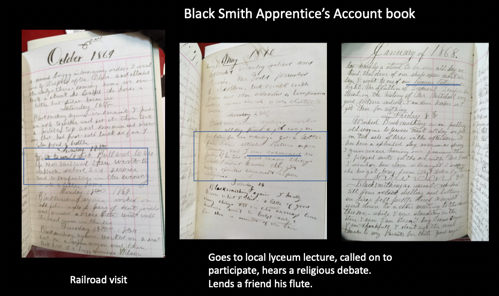
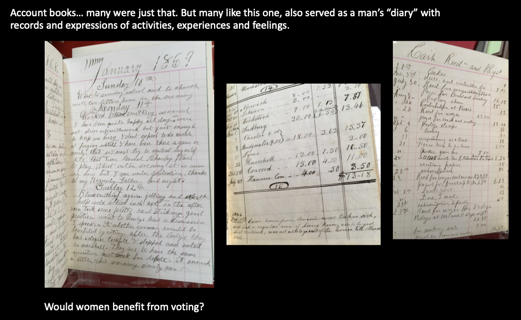
Apprentice Blacksmith’s Account Book. Click the image on the left to view the October 1869 entry in the Account Book.
